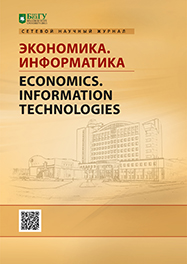IMAGE COMPRESSION USING DISCRETE WEYL – HEISENBERG TRANSFORM
DOI:
https://doi.org/10.18413/2687-0932-2020-47-2-412-421Keywords:
imaging, compression, cosine transform, Hartley transform, Weyl-Heisenberg transform, good localization, optimal basisAbstract
This article proposes a new approach to raster image compression, based on the use of the two-dimensional
real discrete Weyl – Heisenberg transform (DWHT). This discrete transform is orthogonal and is based on the
optimal Weyl – Heisenberg signal basis, which has the best time-frequency localization. The indicated
properties are ensured by choosing the optimal forming function of the basis and the best ratio of its parameters.
In addition, to assess the potential possibilities of using the discrete Weyl – Heisenberg transform in
compression problems, the main criteria for compression efficiency were formulated and DWHT was
compared with other well-known orthogonal transforms – discrete cosine transform (DCT) and discrete
Hartley transform (DHT). It is experimentally shown that the proposed method based on discrete Weyl –
Heisenberg transform has much better compression characteristics. The paper also presents the results of
comparing three compression methods (DHT, DCT and DWHT) in the form of corresponding tables and
figures of the restored images.
Downloads
References
Асирян В.М., Волчков В.П. 2017. Применение ортогонального преобразования Вейля –Гейзенберга для сжатия изображений. Телекоммуникации и информационные технологии. 4 (1): 50–56.
Асирян В.М., Волчков В.П. 2018. Вычислительно эффективная реализация прямого и обратного преобразований Вейля – Гейзенберга. Телекоммуникации и информационные технологии. 5 (1): 5–10.
Ахмед Н., Рао К.Р. 1980. Ортогональные преобразования при обработке цифровых сигналов. Пер. с англ./Под ред. Фоменко И.Б., М.: Связь, 248. (Ahmed N, Rao K.R. 1975. Orthogonal Transforms for Digital Signal Processing. Berlin, Heidelberg, New York: Springer-Verlag, 264).
Волчков В.П., Асирян В.М. 2017. Вычислительно эффективный алгоритм формирования оптимального базиса Вейля – Гейзенберга. Фундаментальные проблемы радиоэлектронного приборостроения. М., МИРЭА. Часть 4: 1151–1154.
Волчков В.П. 2009. Новые технологии передачи и обработки информации на основе хорошо локализованных сигнальных базисов. Научные ведомости БелГУ. Сер. История. Политология. Экономика. Информатика. 15 (70): 181–189.
Волчков В.П., Петров Д.А. 2009. Условия ортогональности обобщенных базисов Вейля – Гейзенберга для OFTDM сигналов. Научные ведомости БелГУ. Сер. История. Политология. Экономика. Информатика. 15 (70): 190–199.
Волчков В.П., Петров Д.А. 2009. Оптимизация ортогонального базиса Вейля – Гейзенберга для цифровых систем связи, использующих принцип OFDM/OQAM передачи. Научные ведомости БелГУ. Сер. История. Политология. Экономика. Информатика.1 (56): 102–112.
Волчков В.П., Петров Д.А. 2010. Обобщенная теорема Найквиста для OFTDM сигналов. Системы синхронизации, формирования и обработки сигналов. М., Издательский дом Медиа паблишер. 1 (1): 28–32.
Добеши И. 2001. Десять лекций по вейвлетам. Ижевск: РХД, 464. (Daubechies I., 1992. Ten Lectures on Wavelets. Philadelphia, Pa.: Society for Industrial and Applied Mathematics, 378).
Ahmed N. et al. 1974. Discrete Cosine Transform. IEEE Transactions on Computers. Vol. C-23, no. 1: 90–93.
Bolcskei H. et al. 1999. Efficient design of OFDM/OQAM pulse shaping filter. Proceedings of IEEE International Conference on Communications (ICC 99). Vol. 1: 559–564.
Gabor D. 1946. Theory of communication. J. Inst. Elect. Eng. (London), vol. 93, no. 111: 429–457.
Hartley R.V. 1942. A More Symmetrical Fourier Analysis Applied to Transmission Problems. Proceedings of the IRE (March), 30 (3): 144–150.
Smith S.W. 1999. The Scientist and Engineer’s Guide to Digital Signal Processing. California Technical Publishing, 2nd ed.: 496–503.
Sunder R. et al. 2006. Medical image compression using 3-D Hartley transform. Computers in biology and medicine, Vol. 36: 958–973.
Volchkov V.P. 2007. Signal bases with good time-frequency localization. Electrosvyaz, no. 2: 21–25.
Volchkov V.P., Petrov D.A. 2009. Orthogonal Well-Localized Weyl-Heisenberg Basis Construction and Optimization for Multicarrier Digital Communication Systems. Proc. of ICUMT, St. Petersburg: Oct.
Volchkov V.P., Sannikov V.G. 2018. Algebraic approach to the optimal synthesis of real signal Weyl-Heisenberg bases. 2018 Systems of Signal Synchronization, Generating and Processing in Telecommunications (SYNCHROINFO 2018). Publ: Institute of Electrical and Electronics Engineers (IEEE), POD Publ: Curran Associates, Inc. (Oct 2018): 135–142.
Volchkov V. et al., 2019. Synthesis of Real Weyl-Heisenberg Signal Frames with Desired Frequency-Time Localization., 2019 24th Conference of Open Innovations Association (FRUCT), Moscow, Russia: 502–508.
Wexler J., Raz S. 1990. Discrete Gabor expansions. Signal Processing, vol. 21, no. 3: 207–220.
Abstract views: 744


